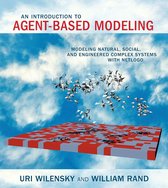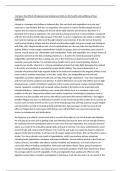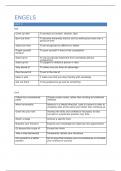Chapter 0
Agent = autonomous computational individual or object with particular properties and
actions (of a computer simulation). Individual elements have properties, states and
behaviours
Agent-based modelling (ABM) = a form of computational modelling whereby a phenomenon
is modelled in terms of agents and their interactions; a computational modelling paradigm
that enables us to describe how any agent will behave
ABM is a methodology that can be promiscuously applied. It is a transformative
representational technology that enables us to better understand familiar topics and is a
species of computation.
Agent-based models are constructed out of individual objects and simple rules for their
movement of behaviour.
ABM encodes the behaviour of individual agents in simple rules so that we can observe the
results of these agents’ interactions (complex systems)
Structuration = the encoding of the knowledge in a domain as a function of the
representational infrastructure used to express the knowledge.
Restructuration = a change from one infrastructure of a domain to another resulting from
such a change in representational infrastructure
Emergence = the arising of novel and coherent structures, patterns and properties through
the interactions of multiple distributed elements.
In complex systems, order can emerge without any design or designer.
Emergence has two fundamental and distinct challenges:
- Trying to figure out the aggregate pattern when one knows how individual elements
behave (integrative understanding)
- The aggregate pattern is known and one is trying to find the behaviour of the
elements that could generate the pattern (differential understanding)
DC mindset = D-component is the destructive of pattern, C-component is a centralized
controller.
ABM is a computational methodology that enables one to model complex systems. Agent-
based models are composed of agents (computational entities that have properties) or state
variables and values.
Agents usually also have a graphical component so you can see them on a computer screen.
An agent can represent any element of a system. The goal of ABM is to create agents and
rules that will generate a target behaviour.
ABM’s enable restructuration of complex systems so that the understanding of a complex
system can be democratized, and the science of complex systems can be advanced.
The core representational infrastructure in the social sciences consists of words and texts.
By capturing social science theories in dynamic ABM representations, we make their
assumptions explicit and they become demonstrations of the consequences of their
assumptions.
,Chapter 1
Model = an abstracted description of a process, object or event.
Models can take many distinct forms. Certain forms of models are easier to manipulate than
other forms.
Computational model = takes certain input values, manipulates those inputs in an
algorithmic way and generates outputs.
Model implementation = the process of transforming a textual model into a working
computational simulation
Conceptual models describe processes, objects or events.
A complex system = a system composed of many distributed interacting parts. Complex
system science provides tools and frameworks for viewing phenomena. Choosing when to
do so depends on assessing when it is most useful to use the lens and/or methodologies of
complex systems. Methodology of complexity science = ABM.
How to test a hypothesis and see if a computational model adequately accounts for what
we observe in nature?
- Create a more algorithmic description of the preceding textual model
Through ABM we understand that complexity can self-organize without a leader.
There are eight main uses for agent-based models:
- Description - Providing focal objects or
- Explanation centerpieces for scientific dialogue
- Experimentation - Thought experiment
- Providing sources of analogy - Prediction
- Communication/education
A model is descriptive of a real-world system. It is a simplification of the real world and does
not contain all of the details and inconsistencies that are present.
Emergence occurs when an attribute that can be describes at a system level is not
specifically encoded at the individual level.
The function of a model is to help us to understand and examine phenomena that exist in
the real world in more tractable and efficient ways than by simply observing reality.
Models are explanatory in that they point out the essential mechanisms underlying a
phenomenon. They can function as a proof that hypothesized mechanisms are sufficient to
account for an observation. Models provide us with a proof of concept that something is
possible.
A key function to ABMs is to explicate the power of the emergence and compare contrast
alternative hypotheses.
Models facilitate experimentation. They can be fun repeatedly to note variations in their
dynamics and in their outputs. Others exhibit path dependence and can vary from run to
run.
, Agent-based models enable us to easily examine different mechanisms and attributes of a
system and see what effect those modifications have on the overall behaviour of the
system.
Regimes are characteristic output behaviours of the model.
Models provide us with analogies, they enable us to find similarities with other such
simplifications even if the modelled phenomena are apparently very different.
Models provide us with an educational tool that encapsulates knowledge that may not be
readily available from real world observation. It allows us to expand knowledge and conduct
experiments.
Focal object = ‘an object to think with’
Models can present new phenomena that are not necessarily about some real-world
phenomena but are thought experiments on possible computations.
A common conception of computer modelling is that its major purpose if prediction, an
agent-based model’s prediction depends on the accuracy of its input data.
Models are used to describe past patterns of behaviour and to explain future patterns that
might arise.
Agent-based models are distinctive from other modelling approaches in that they were
designed in order to understand and explain complex phenomena that otherwise could not
be explained through traditional approaches.
ABM’s core idea is that many phenomena in the world can be effectively modelled with
agents, an environment and a description of an agent-agent and agent-environment
interactions.
The agent in this sense is an autonomous individual or object with particular properties,
actions and goals. The environment is the landscape on which agents interact and can be
geometric, network-based or drawn from real data. The interactions that occur between
these agents or with the environment can be complex. Agents can interact with other
agents or with the environment and not only can the agent’s interaction behaviours change
in time, but so can the strategies used to decide what action to employ at a particular time.
Interactions are constituted by the exchange of information. A result of these interactions,
agents can update their initial state or take additional actions.
Differences between ABM and equation-based models (EBM):
- ABM models individuals it can model a heterogeneous population
- EBM make assumptions of homogeneity
- ABM has a richer concept of time; one model’s agents and their interactions with
each other, it becomes dynamic instead of static
- The results generated by AMB are more detailed (both individual and aggregate)
than those by EMB
- ABM does not require knowledge of the aggregate phenomena; even if you have no
hypothesis as to how the aggregate variables will interact, you can still build a model
and generate results.
Heterogeneity plays a key role. When you model individuals, the interactions and results are
typically discrete and not continuous. Continuous models do not always map well into real-
world situations.




